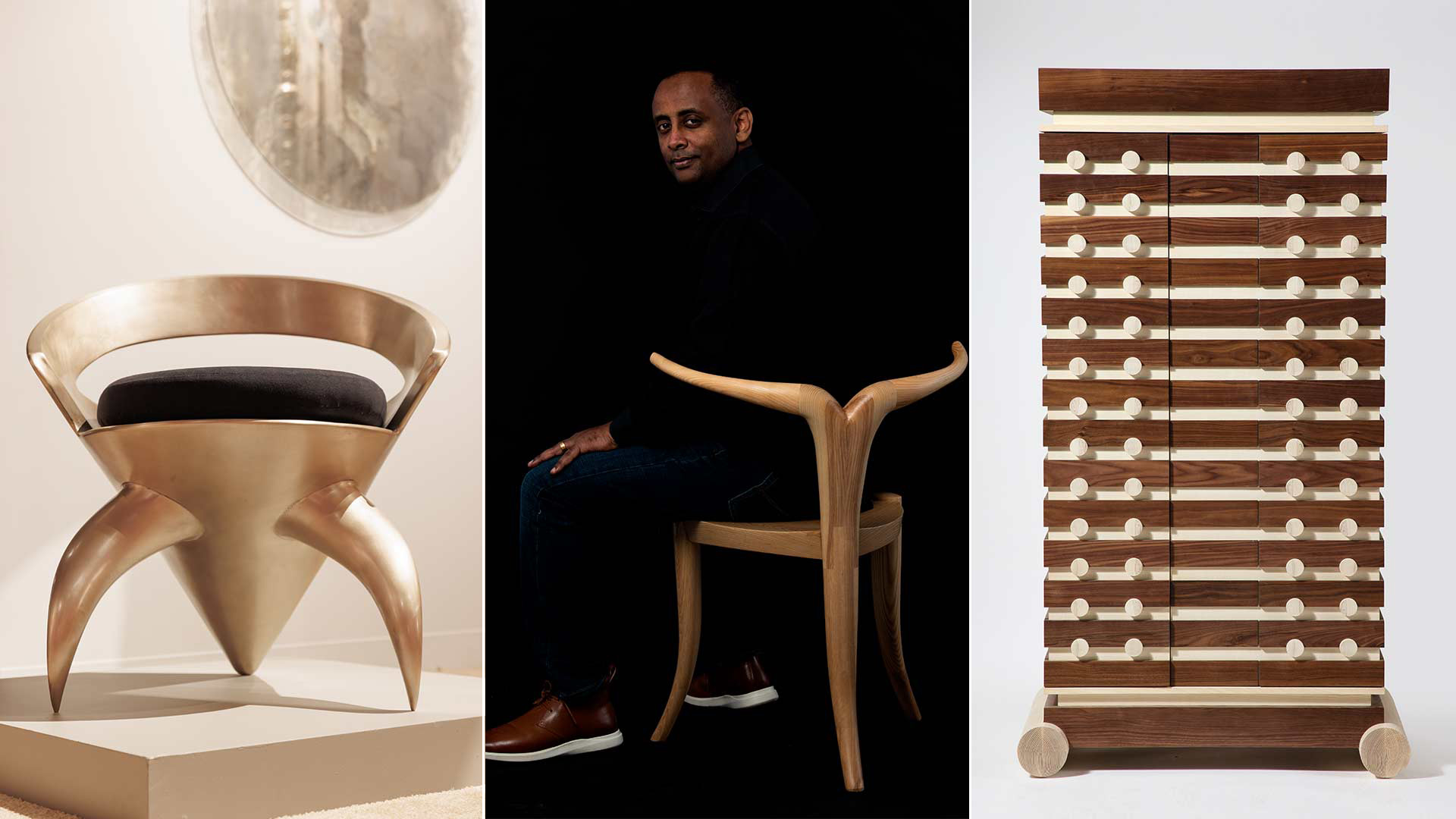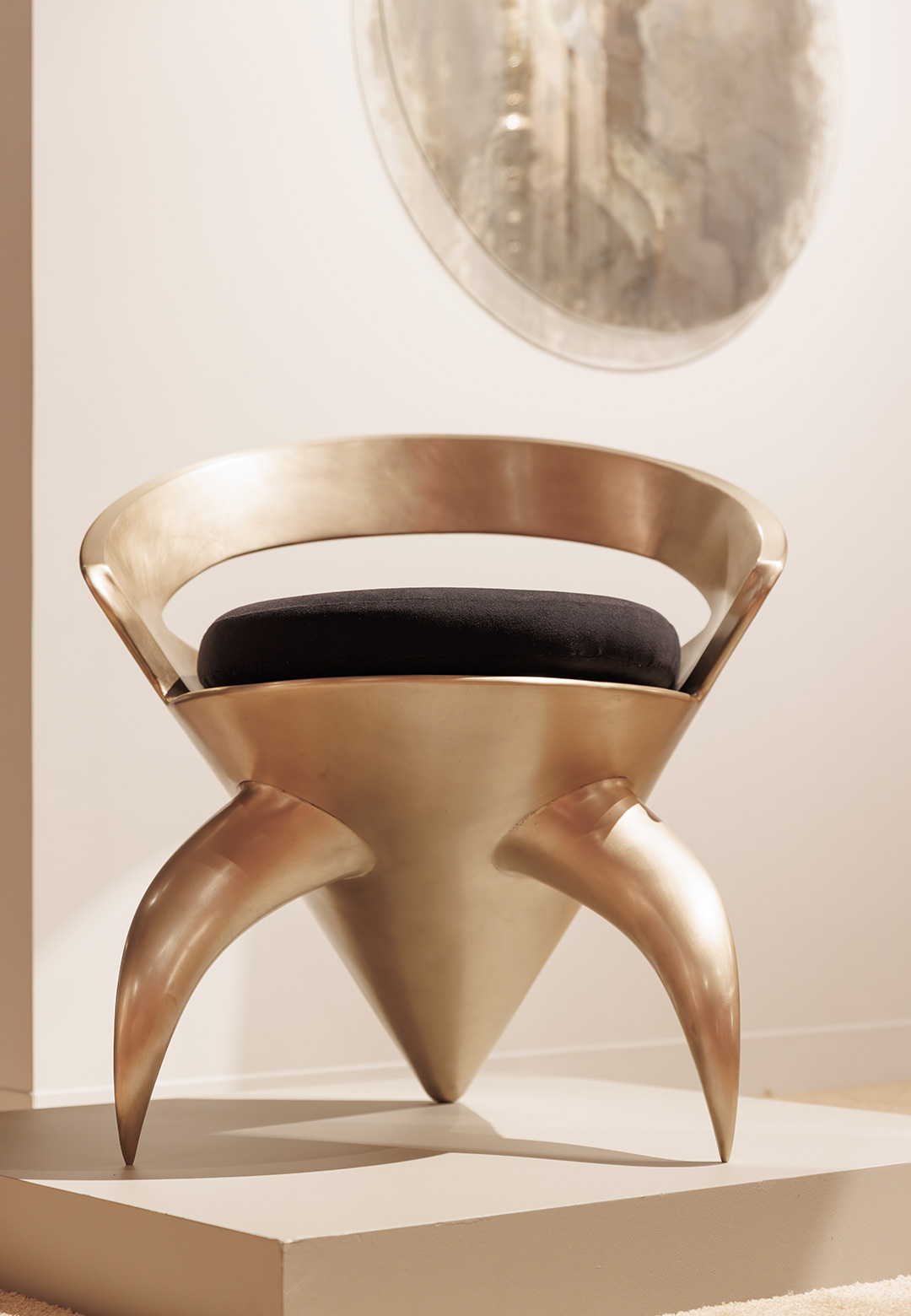As the global design landscape continues to diversify, the resonance of Africa's cultural identity emerges as a powerful narrative in the world of furniture design. In the intricate patterns of woven textiles, the rustic charm of hand-carved wood, and the symbolic significance of indigenous materials, lies a profound connection to the continent's rich heritage. Leading this evocative conversation is Ethiopian American artist and industrial designer Jomo Tariku, whose creations breathe life into Africa's design ethos. Through a harmonious blend of tradition and modernity, Tariku infuses each piece with the spirit of Africa, inviting us to explore the soulful depths of its identity woven into every curve and contour. Tariku’s recent endeavours mark a significant evolution in the African art conversation. Pieces like his Kundung-Pembe Chair and Zagwe Wardrobe expand the boundaries of furniture design, incorporating new materials and categories while honouring cultural symbols.
The Kundung-Pembe Chair represents Tariku's first venture into using bronze for his product designs. This departure from his primary materials of wood and plastic marks a bold exploration of new creative avenues. Bronze is one of the oldest materials used across Africa, from the Bronze Head of Ife in Nigeria to Coptic crosses and Mequmya (prayer staff) in Ethiopia. Inspired by the versatile repurposing of animal horns found across the continent, the chair derives its name from two regions of Africa - Kundung from Nigeria and Pembe (the Swahili word for horn) from Eastern Africa. Its design synthesises a variety of horn shapes, reflecting the wide use of this resource in African cultures.
The design process for the Kundung-Pembe Chair was an intricate journey of exploration and refinement. Tariku explains, “When Wexler Gallery presented me with the opportunity to explore bronze as a medium, I chose to further develop the Kundung Pembe chair concept which was conceived a couple of years ago.” The initial sketch captured a profile that intrigued Tariku, but transforming it into three-dimensional art presented challenges. “My goal was aimed at conveying both artistic and industrial design facets, resulting in functional art pieces,” shares the furniture designer.
The final chair design is a testament to Tariku's commitment to balancing artistic expression with functionality. Unlike the clean and geometric conical shapes initially envisioned, the piece evolved into a derivative of organically shaped horns for the legs, maintaining the original design for the seat. This approach preserves the essence of Tariku's vision while introducing a dynamic look evoking the beauty of African wildlife that imbues the chair with a sense of vitality.
In contrast, the Zagwe Wardrobe represents the product designer’s first large-scale work and foray into case goods, departing from his iconic chair designs. Inspired by the architectural style found in Northern Ethiopia, between the cities of Axum and Lalibela, this piece venerates the past while pushing the dialogue of vernacular design forward. The wardrobe's design language takes cues from the Yemrehana Krestos church in Lalibela, Ethiopia which was designed during Ethiopia’s Zagwe Dynasty. Many rock-hewn churches were built during this time in and around the city. Tariku's creative process for the Zagwe Wardrobe was deeply rooted in research and reverence for Ethiopia's architectural heritage dating back to 900-1200 CE, a period marked by unique creativity and craftsmanship. Echoing the distinct blend of stone and wood, found in ancient structures, this piece captures the essence of that era. The architects at that time even introduced protruding rectangular logs instead of the round shapes found on the Axum Stelae. With alternating textures and material reminiscent of the natural hues of white and brown, this wooden furniture piece pays homage to the timeless elegance of traditional Ethiopian design with a modern aesthetic sensibility.
From conceptual sketches to the final product, Tariku's design process is a journey of discovery and refinement. His approach begins with an immersion into African books covering various aspects of art design, food, landscape, and wildlife. Tariku meticulously studies shapes and colours that intrigue him, allowing them to guide his creative vision. Thumbnail sketches serve as the foundation for Tariku’s designs, which often fuse disparate ideas into cohesive concepts. “The transition to a furniture piece is developed from either the silhouette or any colour or geometric shape that stands out to me,” shares the artist with STIR. Once the concept reaches a certain stage, he employs 3D rendering and 3D printing for further study and analysis, ensuring that each design embodies both his artistic vision and functional integrity.
For Tariku, storytelling is paramount. Each piece serves as a vessel for narratives that honour Africa's diverse traditions. “Every item I design is a reincarnation of a preexisting African theme”, he explains to STIR. By naming his creations after their inspirational sources, the industrial designer invites viewers to delve deeper into the stories and symbolism embedded within his creations. Through this narrative approach, he hopes to foster a deeper appreciation for modern African design and inspire curiosity about its origins.
Throughout his design process, Tariku remains cognizant of the intersection between traditional craftsmanship and contemporary design. “I am a recipient of what has been passed on to me. My designs pay homage to the contributions of past and present artisans while embracing modern tools and materials”, he acknowledges on the synthesis he uses to create pieces infused with heritage and innovation.
Tariku’s perspective on the evolution of modern African design reflects a broader narrative shared within the continent’s creative community. He sees his work as part of a collective effort to redefine perceptions and showcase the diversity of African design. Contrary to misconceptions that African designers are limited to specific styles, he believes that they are exploring a wide range of approaches. From innovative upcycling to the incorporation of traditional techniques with modern materials, designers like Tariku are pushing the boundaries and contributing to a more nuanced understanding of modern African identity.
When STIR asked the industrial designer how he envisions individuals incorporating pieces from his collection into their living spaces, Tariku said that he hopes to evoke a sense of connection and appreciation. Whether admired for their unique aesthetics, cultural resonance, or collectible value, each piece carries the spirit of Africa. “People acquire my work for different reasons, but I design these things to push the African design language and also make sure I make enough noise to change the design canon that still doesn’t recognise the contribution of many African and Black creatives”, he explains.
In a search for authenticity and cultural depth, Tariku's furniture pieces are not just objects of beauty, but reflections of a deeper truth; the enduring legacy of Africa’s cultural heritage. Through his creations, the designer invites us to celebrate the vibrant tapestry of his roots and embrace a vision of design that transcends boundaries. In Tariku’s hands, furniture becomes more than just functional; it becomes a canvas for storytelling, a vessel for memory and a symbol for the enduring spirit of innovation.






 Sign in with email
Sign in with email










What do you think?